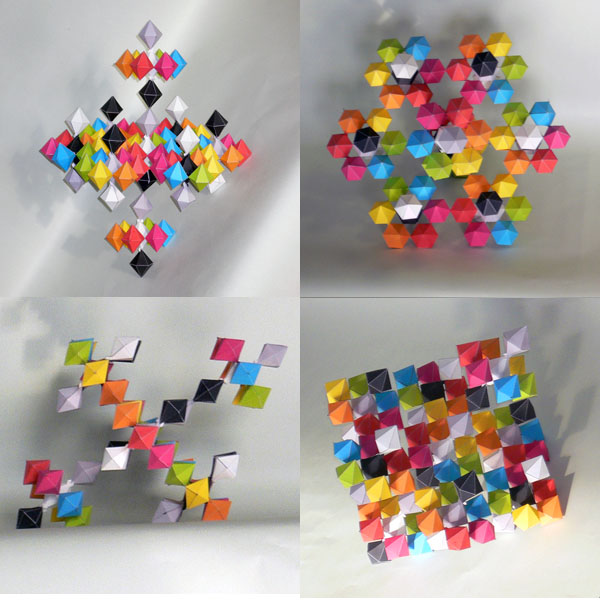Hideki Tsuiki
"Does it look square?---Fractal University Kyoto"
Polyurethane foam pieces covered with printed papers and connected by wires,
55 cm X 30 cm X 50 cm, 2005.

This sculpture has the shape of the 64-pieces approximation of the Sierpinski
tetrahedron, and two square pictures extended with the rate 1:√3 are cut
into 64 pieces and pasted on two faces of the tetrahedrons. We can view one
picture from an edge, and the other one from the opposite side. The tetrahedrons
are made of polyurethane foam, which are connected by wires at their vertexes.
"Hexagonal Bipyramid Fractal with a SUDOKU coloring"
Paper pieces connected by wires, 24 cm X 24 cm X 24 cm, 2006.

This sculpture has the shape of the 2nd level approximation of the hexagonal
bipyramid fractal. It consists of 81 hexagonal bipyramid pieces and has the
square shape in 6 directions (or 12 directions if opposite directions are counted
twice). In each of these directions, each bipyramid piece has the square shape
and we have 9x9 small squares. This is nothing but the "SUDOKU" grid. In this
sculpture, 9 colors are assigned to the 81 hexagonal bipyramids so that each
column, row, and 9-block have all the nine colors when it is looked at in each
of the 6 directions.
"Cubic model of the Hexagonal Bipyramid Fractal"
Paper pieces with a wire, 15cm X 15cm X 15cm, 2006.

This sculpture also has the shape of the 2nd level approximation of the hexagonal
bipyramid fractal. It consists of 81 cubic pieces and it has the square projection
in 3 directions. It is made of six A4-size papers and supported by one wire
in the center. It is assembled without paste or cellophane adhesive tape, and,
it can be disassembled to flat paper pieces.
"Tessellation in the Cube"
Acrylic resin and paper, 8.5 cm X 8.5 cm X 8.5 cm, 2007.

It is simply a cube which contains two regular triangular sheets with triangular-tessellating
drawings on both sides. The cube is made of acrylic resin blocks. When it is
viewed from the six faces, the two triangular pictures are connected and affine
transformed to form square pictures. Drawings by Yumiko Ihara.
"Tessellation in the Rhombohedron"
Wires and paper, 30 cm X 10 cm X 10 cm, 2007.

The above cubic object can be affine transformed to a rhombohedron. Since projection
is preserved by affine transformations, this object also has six directions
in which the two pictures are connected. It has some advantages to the cubic
one. First, the connected image is a rhombus, which is close to the original
rhombus of two regular triangles. Second, one can easily rotate this object
to see the three images. Drawings by Yumiko Ihara.
Hideki Tsuiki
Associate Professor of Mathematics and Computer Science, Graduate School of Human and Environmental Studies, Kyoto University, Japan
"Fractals in three-dimensional space are interesting in that they have attractive shadow images which change smoothly. The author is particularly interested in the case they have fractal dimension two and have solid square shadow images in three (or more) directions. Details are given in my paper in the proceedings. Models of such fractals have some artistic and educational meanings. Firstly, fractal shadow images are themselves beautiful. Secondly, because they have solid square images, one can put pictures on them. Thirdly, one can visually understand the meanings of fractal dimension and Hausdorff measure through them."